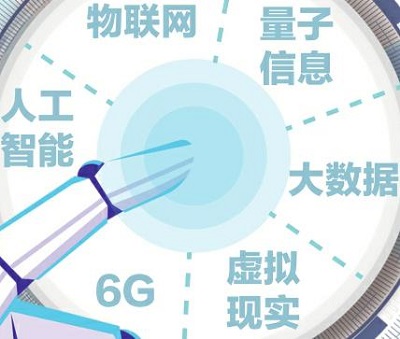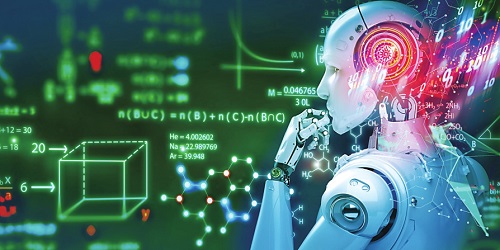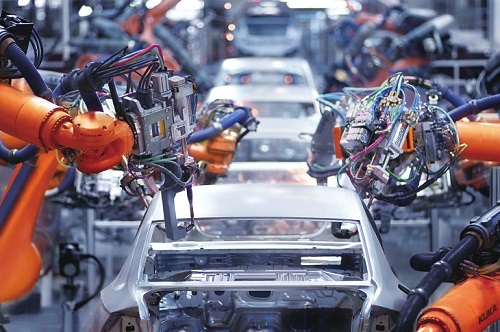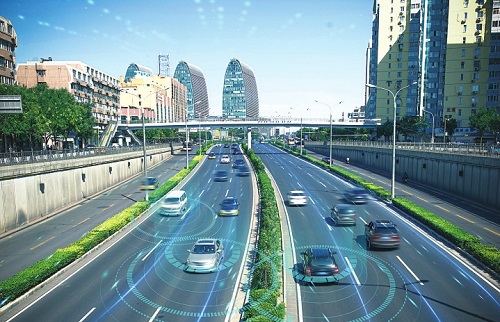Focus of this issue: scientific and technological innovation | innovation boosts high-level scientific and technological self-reliance and self-improvement
"The contribution rate of scientific and technological progress has increased to more than 60%, and the ability of innovation to support development has been continuously enhanced." "Innovative achievements in the fields of large aircraft manufacturing and artificial intelligence are constantly emerging" … In the 2023 government work report, scientific and technological innovations are inspiring.
Scientific and technological innovation and technological progress are the core competitiveness of a country. In recent years, China’s scientific and technological undertakings have developed by leaps and bounds, the ability of scientific and technological innovation has been accelerated, and the role of science and technology as the primary productive force has been further exerted. The data shows that China’s global innovation index ranking rose from the 34th in 2012 to the 11th in 2022, and it successfully entered the ranks of innovative countries, opening a new stage of realizing high-level scientific and technological self-reliance and building a powerful country in science and technology.
This year’s government work report pointed out that science and technology policy should focus on self-reliance and self-improvement. Improve the new national system, give full play to the organizational role of the government in tackling key core technologies, and highlight the main position of scientific and technological innovation of enterprises. In the field of information and communication, from 6G and artificial intelligence to the Internet of Things and quantum information, innovation has never stopped. To further promote high-level scientific and technological self-reliance, build a strong country in science and technology, and run the concept of innovation and development through the whole process of modernization, we need to strive to create a good ecological environment for scientific and technological innovation, and we need to unite all forces to form a joint force.
At present, the clarion call of scientific and technological innovation is sounded again, and the national strategic orientation and the needs of various subjects strongly resonate. In the fertile soil where all things germinate and flourish, science and technology will inject more wisdom into high-quality development.
Scientific and Technological Innovation in Government Work Report
Scientific and technological innovation has yielded fruitful results.Build a new national system, set up national laboratories, and promote the reorganization of national key laboratories in batches. Some key core technologies have made new breakthroughs, and innovations in manned space flight, lunar exploration, deep-sea exploration, supercomputers, satellite navigation, quantum information, nuclear power technology, large aircraft manufacturing, artificial intelligence and other fields have emerged. The investment intensity of R&D funds in the whole society has increased from 2.1% to more than 2.5%, the contribution rate of scientific and technological progress has increased to more than 60%, and the ability of innovation to support development has been continuously enhanced.
Enhance the leading role of scientific and technological innovation.Strengthen the national strategic scientific and technological strength, implement a number of major scientific and technological innovation projects, and strengthen key core technology research. Give full play to the role of universities and research institutes and support the development of new R&D institutions. Promote the construction of international and regional science and technology innovation centers and lay out the construction of comprehensive national science centers. Support basic research and applied basic research, and the national basic research funds have doubled in five years. Reform the management system of scientific research projects and funds to give scientific research units and researchers greater autonomy. Strengthen intellectual property protection and stimulate innovation. Promote international scientific and technological exchanges and cooperation. Through the market-oriented mechanism, enterprises are encouraged to innovate, and the deduction ratio of R&D expenses of enterprises is continuously increased, from 50% and 75% to 100% for manufacturing enterprises and small and medium-sized science and technology enterprises respectively, and it is expanded to all applicable industries in stages. The annual scale of various tax preferential policies supporting innovation has exceeded one trillion yuan. Create financial policy tools to support innovation and guide the development of venture capital. Enterprise R&D investment maintained double-digit growth, and a large number of innovative enterprises stood out.

6G

After several generations’ efforts, China’s mobile communication has achieved the leap-forward development of 2G following, 3G breakthrough, 4G synchronization and 5G leading, and its strategic, basic and leading role in China’s economic and social development has become increasingly prominent, becoming the core engine of social development. As the next generation mobile communication technology, the 6th generation mobile communication (6G) is another opportunity for China to climb the peak of mobile communication after 5G.
With the large-scale commercialization of 5G network, 6G, as the cornerstone of future communication, has quickly entered the global mobile communication industry. At present, major economies in the world have started the research and development of 6G networks, and the research and development of 6G in China has also been significantly accelerated since 2022. 6G will integrate the development trend of core technical elements in the field of pan-information communication, making its technical connotation, industrial category and strategic value far exceed that of traditional mobile communication, and it is the commanding height of global scientific and technological innovation and competition.
At the first "Ministerial Channel" of the First Session of the 14th National People’s Congress held recently, Jin Zhuanglong, Minister of Industry and Information Technology, introduced that the Ministry of Industry and Information Technology is currently summing up the experience of promoting 5G, supporting the industry to set up a 6G promotion group, code-named "IMT-2030(6G) promotion group", which is already working.
In the next step, Jin Zhuanglong said, the key point is to maintain the good development momentum of 5G, and the specific measures can be summarized as "building", "using" and "researching". At present, China has built the largest and most advanced 5G network, and China’s 5G development has been at the forefront of the world. The data shows that China has built more than 2.34 million 5G base stations, and the number of 5G mobile phone users has exceeded 575 million. More than half of the 97 categories in the national economy use 5G, such as mining, ports, electricity, and large aircraft manufacturing.
Especially for "research", Jin Zhuanglong said: "From the perspective of the development process of 5G, giving full play to the role of government, enterprises and research institutions, it seems that the effect is very good now. We must give full play to the advantages of ultra-large-scale market and complete industrial system. Industry-University-Research will use concentrated efforts to strengthen international cooperation and accelerate 6G research and development. "
artificial intelligence

Emerging industries are new pillars and new tracks leading the future development. Among them, artificial intelligence (AI) is increasingly integrated into the whole process of various fields of economic and social development, and has become an important driving force to promote the leap-forward development of science and technology, industrial optimization and upgrading, and the overall leap of productivity. In recent years, China’s artificial intelligence has accelerated its development, and a complete industrial system has been formed, and a number of "specialized and innovative" enterprises have thrived. This year’s government work report mentioned that it is necessary to accelerate the development of digital industries such as artificial intelligence.
At present, generative AI has a strong development momentum, which refers to the technology of creating new content by using existing text, audio files or images. The key technology of generative AI is generative countermeasure network, which is a deep learning model in essence. The hot performance of ChatGPT in the past year is the best example of the rapid development of AI technology.
Wang Zhigang, Minister of Science and Technology, said that ChatGPT attracted attention because it, as a big model, effectively combined big data, big computing power and strong algorithms. Its calculation method has improved. The same principle lies in whether it is done well. For example, engines, everyone can make engines, but the quality is different. Playing football is dribbling and shooting, but it is not easy to be as good as Messi. From this point of view, it is very difficult for ChatGPT to make technological progress, especially to ensure the real-time performance and the effectiveness of the algorithm quality. We can understand and talk with people’s natural language through calculation, but it is not easy to achieve real-time effect. OpenAI has its advantages in this respect.
Statista, a third-party statistical platform, predicts that the AI market will maintain an average annual growth rate of 50.7%. By 2025, the global artificial intelligence market will reach 36.9 billion US dollars, and the capabilities of artificial intelligence in image (including face) recognition, speech recognition, industrial/manufacturing brain, predictive analysis and automation (including autonomous driving) will continue to improve.
Internet of things

At the World Summit on the Information Society in 2005, the International Telecommunication Union formally put forward the concept of "Internet of Things", suggesting that the ubiquitous communication era of "Internet of Things" is coming, and all objects in the world, from tires to toothbrushes, from houses to paper towels, can actively exchange information through the Internet.
The technical idea of the Internet of Things is "connecting everything on demand". Specifically, all objects (including all entities and virtual physical objects and terminal equipment) that can be independently identified, including people, machines and objects, are connected everywhere according to requirements through various network technologies and information sensing equipment such as radio frequency identification (data exchange through radio to achieve information identification), infrared sensors, global positioning systems and laser scanners, and information transmission and collaborative interaction are carried out. In order to realize the intelligent information perception, identification, location, tracking, monitoring and management of objects, and build an intelligent service environment with the ability of anthropomorphic knowledge learning, analysis and processing, automatic decision-making and behavior control among all objects.
With the popularization of Internet of Things applications, trillions of new devices with different application requirements, such as smart wearable devices, smart home appliances, intelligent networked cars, intelligent robots, smart medical care, farmland water conservancy and municipal buildings, will be connected to the network. These applications are exploding and forming massive data, which promotes the further digitalization, networking and intelligence of production, life and social management, and promotes more intelligent and efficient economic and social development.
At present, China has built the largest mobile Internet of Things in the world, with the number of connections reaching 1.845 billion, accounting for more than 70% of the total number of connections in the world, becoming the first country in the world to realize "superman". Mobile Internet of Things has been widely used in digital city construction, intelligent manufacturing, intelligent transportation, mobile payment and other fields, which has profoundly changed people’s lifestyle. With the continuous development of Internet of Things technology, the Internet of Things industry in China will achieve greater development in the future.
Quantum information

The development of quantum information is of great scientific significance and strategic value. It is a major subversive technological innovation that impacts and reconstructs the traditional technological system and will lead a new round of scientific and technological revolution and industrial transformation. Quantum information mainly includes quantum communication, quantum calculation, quantum precision measurement and so on. In recent years, China has increased its research investment in quantum science and technology, and its technological innovation is active. Through relay propulsion, we have followed and ran to lead in the field of quantum information, and innovative achievements have emerged continuously.
The development of quantum communication is closely related to national information security and strategy, and countries attach great importance to it. In recent years, China has accelerated the construction of quantum communication network and has successfully advanced into the first echelon in the world. At present, quantum communication has the preliminary commercial conditions, and China is actively building a quantum secure communication network. China actively promotes the construction of ground quantum communication networks such as Beijing-Shanghai trunk line/Wuhe trunk line/Beijing MAN/Hefei MAN, and China University of Science and Technology takes the lead in developing Mozi quantum communication satellite and realizing the distribution of quantum keys from satellite to ground spanning 4,600 kilometers.
In the recently hit sci-fi movie Wandering Earth 2, the scene that MOSS, a quantum computer in China, works with thousands of "planetary engines" around the world with powerful computing power is shocking. In 2020, China University of Science and Technology built a 76-photon quantum computing prototype "Nine Chapters"; In October 2021, the upgraded version of "Nine Chapters No.2" of "Nine Chapters" was successfully built, which once again set a new record for the technical level of international optical quantum manipulation. Its handling of specific problems is billions of times faster than the fastest supercomputer in the world. Coupled with the superconducting quantum computer "Zu Chongzhi II" released by China University of Science and Technology in October 2021, this series of remarkable achievements indicates that China has become the only country in the world that has reached the milestone of "quantum superiority" on the two "tracks" of superconductivity and optical quantum.
It can be seen that China has made great efforts to play a "first move" and mastered more key technologies with independent intellectual property rights on the new world science and technology frontier tracks such as quantum computing, laying a solid foundation for participating in international science and technology competition and seizing the track of quantum science and technology development.
big data

Big data industry is a strategic emerging industry focusing on data generation, collection, storage, processing, analysis and service. It is the key support to activate the potential of data elements and an important engine to accelerate the quality change, efficiency change and power change of economic and social development. The latest data shows that the scale of China’s big data industry reached 1.57 trillion yuan in 2022, an increase of 18% year-on-year, and it has become an important force to promote the development of the digital economy.
Digital infrastructure has achieved leap-forward development. By the end of 2022, China has built the world’s largest optical fiber network, with a total optical fiber mileage of nearly 60 million kilometers, a total data center rack of nearly 6 million standard racks, and more than 2.3 million 5G base stations nationwide, all of which rank among the top in the world. The innovation and development of the digital industry has accelerated. The number of invention patents granted in artificial intelligence, Internet of Things and other fields ranks among the top in the world, and the scale of core industries in the digital economy has accelerated. The national software business revenue has increased from 2.5 trillion yuan in 2012 to 10.8 trillion yuan in 2022. Digital empowerment of the real economy has achieved remarkable results. In 2022, the digital transformation of China’s manufacturing industry was further promoted, and the development of intelligent agriculture was accelerated. The comprehensive mechanization rate of crop cultivation and harvest has exceeded 72%, effectively improving agricultural production efficiency. The digitalization level of the service industry has improved significantly, and the scale of e-commerce and mobile payment is leading in the world.
At this year’s National People’s Congress, the State Council’s institutional reform plan mentioned the establishment of a national data bureau, which is responsible for coordinating and promoting the construction of basic data systems, coordinating the integration, sharing, development and utilization of data resources, and coordinating the planning and construction of digital China, digital economy and digital society. It can be seen that the establishment of the National Data Bureau corresponds to the digital strategic transformation of the whole country, which is of great significance to the development and sharing of data resources, as well as the formulation of data policies and the exchange of data transactions. We also expect data elements to further stimulate market potential, release innovation vitality and further empower the high-quality development of the digital economy.
VR(Virtual Reality)

Virtual reality (including augmented reality and mixed reality) is an important frontier direction of the new generation of information technology and a major forward-looking field of digital economy, which will profoundly change the production and lifestyle of human beings. After years of development, the virtual reality industry has initially built an ecosystem based on technological innovation, and is entering a strategic window period with product upgrading and integrated application as the main line.
At present, domestic and foreign technology giants continue to exert their efforts in the virtual reality industry, and the sensing, interaction, modeling and presentation technologies of virtual reality have continuously made breakthroughs, and users’ experience in interaction, display and wearing comfort has also been continuously improved. With vr-platform’s common problems such as wearing dizziness and transmission delay being gradually solved, the production industry of virtual reality content such as movies, games, social interaction and live broadcast has gradually matured, and the virtual reality industry has become increasingly mature and perfect in hardware, software and content applications.
In recent years, the state attaches great importance to the iterative development of virtual reality technology, and has issued a number of policies such as the Action Plan for the Integration of Virtual Reality and Industrial Applications (2022-2026). Breakthroughs in research and development of key sub-sectors such as near-eye display, rendering processing, perceptual interaction, network transmission, content production, compression coding, security and trustworthiness will be the focus of industrial development and technical research in the next period. Thanks to this, virtual reality will further strengthen its deep integration with new generation information technologies such as 5G and artificial intelligence, and the endogenous ability and empowerment ability of "Virtual Reality" will be effectively improved.
China’s virtual reality innovation ability will be significantly enhanced. A systematic innovation system of multi-technology integration and Industry-University-Research’s efficient collaboration has basically taken shape, and important breakthroughs have been made in key core technologies such as near-eye display and rendering processing. Virtual reality standards have been further studied and formulated, and a number of radio and television and network audio-visual virtual reality production experimental zones and virtual reality empowerment stage art digital production experimental zones have been built. It is estimated that by 2026, the overall scale of China’s virtual reality industry (including related hardware, software, applications, etc.) will exceed 350 billion yuan, and the sales of virtual reality terminals will exceed 25 million units.
Voice of deputies
Li Dongsheng, NPC deputy and chairman of TCL:
We must break through the key core technology of "sticking the neck"
Li Dongsheng, deputy to the National People’s Congress and founder and chairman of TCL, said: "The government work report presents the overall achievements of China’s economic and social development in the past five years, and puts forward practical suggestions and goals for future development, which is inspiring and inspiring. Under the current situation, scientific and technological innovation is not only a development issue, but also a survival issue. For high-quality development, technological innovation is the first driving force. "
Li Dongsheng said: "China’s science and technology manufacturing industry will play an extremely important role in high-quality development. Under the current situation, we can only take the road of self-reliance and self-improvement through science and technology, and we must break through the key core technologies of’ stuck neck’, such as integrated circuits, precision materials, core devices, high-end equipment and other fields. "
In addition, the government work report once again emphasizes the need to highlight the main position of enterprise innovation and let enterprises play a greater role in scientific and technological innovation. In the past five years, the annual scale of various tax incentives to support innovation has exceeded one trillion yuan, which greatly encouraged the confidence of enterprises to invest in R&D and enhanced their innovation momentum. "Enterprises are duty-bound to continue to promote scientific and technological innovation. I feel a great responsibility. In the future, we should focus on the weak links in the industrial chain, dare to advance into the technology no man’s land, and dare to tackle major technical problems. " Li Dongsheng said.
Zhou Yunjie, deputy to the National People’s Congress and chairman of the board of directors of Haier Group:
Strengthening the national strategic scientific and technological strength with scientific and technological innovation
At this year’s National People’s Congress, Zhou Yunjie, Chairman and CEO of Haier Group, submitted "Suggestions on Giving Full Play to the Role of Leading Enterprises in Science and Technology and Improving the Coordination Mechanism of National Strategic Science and Technology Forces", focusing on the system and mechanism problems existing in the coordination organization of various scientific and technological forces, the stimulation of talents’ vitality and the improvement of talents’ ability, and making suggestions for strengthening China’s strategic science and technology forces and realizing high-level scientific and technological self-reliance.
"To establish a scientific and technological innovation system in the whole industry chain, enterprises, universities and research institutes should establish a targeted innovation system from the perspective of the whole industry chain, so that the innovation of 0→1 and 1→N can be seamlessly connected." Zhou Yunjie gave such suggestions for building an innovation consortium and enhancing the national strategic scientific and technological strength. He pointed out that a group of leading enterprises in science and technology should be selected, and the enterprises should take the lead in organizing universities and scientific research institutions to carry out the whole process pilot of "industrial demand-technical problems-scientific research-industrial application" with special support methods such as "revealing the list and taking the lead", forming a model that can be used for reference and replicated.
"After the product economy and platform economy, the future will be an ecological economy. Enterprises and universities must tear down the walls. Only when cross-border integration forms an innovative ecology can they develop better." Zhou Yunjie believes that the deep integration of schools and enterprises can cultivate more talents that meet the needs of the times and fully release the vitality of scientific and technological talents.
Liu Qingfeng, deputy to the National People’s Congress and chairman of Iflytek:
Continue to promote the R&D and upgrading of cognitive intelligence big model technology in China.
At present, the breakthrough of cognitive intelligence technology represented by ChatGPT has aroused global hot discussion and concern. Liu Qingfeng proposed that we should speed up the construction of a large model of cognitive intelligence in China, and let the industry enjoy the AI dividend as soon as possible on the self-controlled platform, so that everyone can have an AI assistant.
At present, although many institutions and enterprises in China have released a series of large models, they have not really taken the systematic algorithm paths such as pre-training of large models, supervised training based on Prompt tasks and reinforcement learning based on human feedback, and the intelligence level of large models is still significantly lower than that of ChatGPT.
ChatGPT-like R&D is a systematic project with continuous evolution, with high task difficulty and large investment. It is suggested that China should take leading scientific and technological enterprises as the main body of innovation, unite national strategic scientific and technological forces such as national laboratories and national key laboratories, build a long-term and stable cooperative innovation system in Industry-University-Research under the overall planning and support of national special projects, and continue to promote the technological R&D and upgrading of China’s cognitive intelligence model. In addition, in order to support the domestic hardware and software technology base of artificial intelligence for large-scale model research and development and service, China cognitive intelligence model can only have a self-controlled future if it is developed on the domestic technology base.
The research and development and service of large-scale models can only be promoted safely and continuously for a long time on the domestic basic software and hardware platforms such as storage, computing power and operating system, effectively avoiding the "stuck neck" problem in some links in the future. Support large-scale model research and development institutions to establish long-term strategic cooperation with domestic artificial intelligence software and hardware institutions, and work together to ensure that the technical base is autonomous and controllable.
Guo Lei, deputy of the National People’s Congress and professor of Beijing University of Aeronautics and Astronautics:
Based on basic theory and full chain innovation, serving the country’s major needs
The national strategic scientific and technological strength has been accelerated, and important progress has been made in tackling key core technologies. But we also deeply feel that there are still uncertainties and unpredictable risks in the international situation. The vast number of scientific and technological workers can play an important role in the new journey of realizing the great rejuvenation of the Chinese nation, which is both a great honor and a great responsibility. We will continue to carry forward the spirit of perseverance in serving the country, solve difficult problems and activate our strength, and make greater contributions to the country’s high-level science and technology.
Guo Lei believes that it is necessary to apply the wisdom of the vast number of scientific researchers to the places where the motherland needs them most. He suggested that from the aspects of scientific research system, talent incentive and evaluation mechanism, the whole chain innovation from basic theoretical research, algorithms, software, hardware and equipment to major engineering applications should be carried out in order to accelerate the close integration of basic theoretical research and major national needs and realize the dialectical unity of these two major goals.
Deng Zhonghan, member of Chinese People’s Political Consultative Conference and commander-in-chief of Starlight China Core Project:
The core technical standard is the commanding height of scientific and technological innovation
During the two sessions of the National People’s Congress this year, Deng Zhonghan, member of Chinese People’s Political Consultative Conference and commander-in-chief of "Starlight China Core Project", proposed that in the post-Moore era, we should continue to innovate with high quality to build a self-reliant and self-reliant ecosystem.
He said that in the new era and new situation, the drive of high-quality innovation is closely integrated with the destiny of the country, and strong innovation will make the country prosperous. Scientific and technological innovation is an important force in national construction and development, which provides a strong support for the construction of an innovative country and a strong country in science and technology. In Deng Zhonghan’s view, scientific and technological workers should have the mind and responsibility to serve the country through science and technology, sit on the bench for ten years, have patience and confidence, devote themselves to continuous innovation and high-quality innovation of key technologies, and open up a new track for scientific and technological innovation in the post-Moore era.
Deng Zhonghan called on the government and scientific and technological enterprises to pay attention to the study of core technical standards, and hoped to get the support of the whole society, because scientific and technological innovation can not be separated from standard innovation, and core technical standards have become the commanding heights of scientific and technological innovation. Standards are an important support for scientific and technological innovation and economic and social development, an important carrier of technical rules and basic systems, and are related to national competitiveness, international discourse power and the strategic overall situation of the global industrial chain.
Guo Yufeng, member of Chinese People’s Political Consultative Conference and deputy general manager of Feiteng Company:
Continue to promote the breakthrough of core chip industry and build a secure base for digital economy.
As the cornerstone of industrial development in the era of digital economy, chips are directly related to the national strategic security and industrial development security, and are also an important support for realizing self-reliance and self-reliance in science and technology. Guo Yufeng believes that unswervingly and vigorously developing domestic CPU is an inevitable choice for national strategy and industrial development. Only by continuously promoting breakthroughs in the core chip industry can we build a secure base for the digital economy.
In order to promote and support the development of chip industry, the state has successively issued a series of industrial support policies, which have promoted the rapid development of domestic CPU through the application of major projects. Domestic software and hardware products have gradually realized the rapid development from "unavailable" to "available" and then to "basically easy to use", and the domestic ecology has shown the development trend from weak and closed to prosperous and open, and has also realized the application from pilot to small scale and then to large scale.
In view of the severe challenges faced by domestic chips at present, we should give full play to the advantages of the new national system, concentrate on tackling difficulties, make overall plans for key layouts, strengthen market practice to help products mature, and pool market resources to feed back scientific and technological innovation, so as to break through difficulties.
The first suggestion is to adhere to the development concept of "paying equal attention to autonomy and ecology" and accelerate the convergence of technical routes. The second is to give play to the role of enterprises as the main body of innovation and accelerate the establishment of a positive cycle of R&D and market. The third is to seize the key opportunities of industrial transformation and achieve breakthroughs in the information industry.